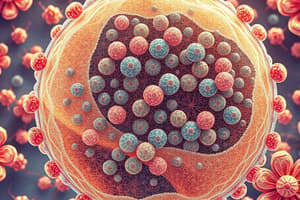Podcast
Questions and Answers
What is the whip-like structure used for movement?
What is the whip-like structure used for movement?
flagella
Which of these is NOT true of the cell membrane?
Which of these is NOT true of the cell membrane?
- It is made of protein, glucose, and cholesterol. (correct)
- It is selectively permeable.
- It contains cholesterol.
- It is primarily made of lipids.
Facilitated diffusion depends on?
Facilitated diffusion depends on?
proteins that are part of the cell membrane
What is the process called when water and dissolved materials move through a membrane from high pressure to low pressure?
What is the process called when water and dissolved materials move through a membrane from high pressure to low pressure?
What is the movement of molecules from an area of greater concentration to lesser concentration called?
What is the movement of molecules from an area of greater concentration to lesser concentration called?
What provides the energy for diffusion?
What provides the energy for diffusion?
How are small molecules like oxygen and carbon dioxide exchanged in tissues?
How are small molecules like oxygen and carbon dioxide exchanged in tissues?
What is the movement of molecules from an area of lesser concentration to greater concentration called?
What is the movement of molecules from an area of lesser concentration to greater concentration called?
What provides the energy for active transport?
What provides the energy for active transport?
What is the diffusion of water through a selectively permeable membrane called?
What is the diffusion of water through a selectively permeable membrane called?
Which statement is NOT true of cellular transport processes?
Which statement is NOT true of cellular transport processes?
If human cells are placed in a hypertonic solution, what will happen?
If human cells are placed in a hypertonic solution, what will happen?
If human cells are placed in a hypotonic solution, what will happen?
If human cells are placed in a hypotonic solution, what will happen?
If human cells are placed in an isotonic solution, what will happen?
If human cells are placed in an isotonic solution, what will happen?
Human cells will lose water and shrivel if they are placed in a ___ solution.
Human cells will lose water and shrivel if they are placed in a ___ solution.
Human cells will absorb water and swell and burst if they are placed in a ___ solution.
Human cells will absorb water and swell and burst if they are placed in a ___ solution.
A solution with a greater salt concentration than cells is said to be?
A solution with a greater salt concentration than cells is said to be?
A solution with a lesser salt concentration than cells is said to be?
A solution with a lesser salt concentration than cells is said to be?
In a coffee maker, osmosis is used to make coffee.
In a coffee maker, osmosis is used to make coffee.
The skin swells and puckers during a long bath. This suggests that bath water is a(n) ________ fluid.
The skin swells and puckers during a long bath. This suggests that bath water is a(n) ________ fluid.
How does facilitated diffusion differ from ordinary diffusion?
How does facilitated diffusion differ from ordinary diffusion?
Flashcards are hidden until you start studying
Study Notes
Movement Structures and Cell Transport
- Flagella: A whip-like structure used for movement in certain cells.
Cell Membrane Characteristics
- Composition Misconception: The cell membrane is not solely made of protein, glucose, and cholesterol; this statement is incorrect.
Types of Diffusion
- Facilitated Diffusion: Relies on specific proteins within the cell membrane to assist in the transport of molecules.
- Diffusion: Involves the movement of molecules from an area of higher concentration to an area of lower concentration; no external energy is required.
- Osmosis: A specific type of diffusion focused on the movement of water through a selectively permeable membrane.
Pressure-Based Movement
- Filtration: The process where water and dissolved substances move through a membrane from high pressure to lower pressure.
Concentration Gradient Dynamics
- Active Transport: Involves moving molecules against a concentration gradient, from lower to higher concentration, requiring energy in the form of ATP.
Effects of Solutions on Human Cells
- Hypertonic Solution: Causes human cells to lose water and shrivel due to higher salt concentration outside the cell.
- Hypotonic Solution: Results in cells absorbing water, swelling, and potentially bursting because of lower salt concentration.
- Isotonic Solution: Maintains cell size as concentrations inside and outside are equal.
Transport Process Misconceptions
- The statement that filtration is the movement from low to high concentration is incorrect.
Osmosis and Everyday Examples
- Long exposure to bath water (hypotonic fluid) causes skin to swell and pucker.
- Use of osmosis in coffee making is falsely attributed; it does not employ osmotic principles.
Facilitated Diffusion vs. Ordinary Diffusion
- Facilitated diffusion is limited by the number of protein channels available, unlike ordinary diffusion, which does not have this limitation.
Studying That Suits You
Use AI to generate personalized quizzes and flashcards to suit your learning preferences.




